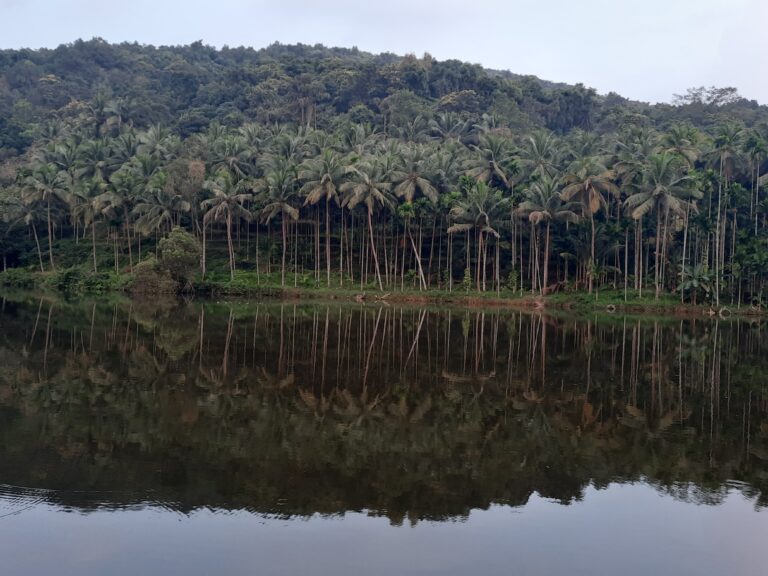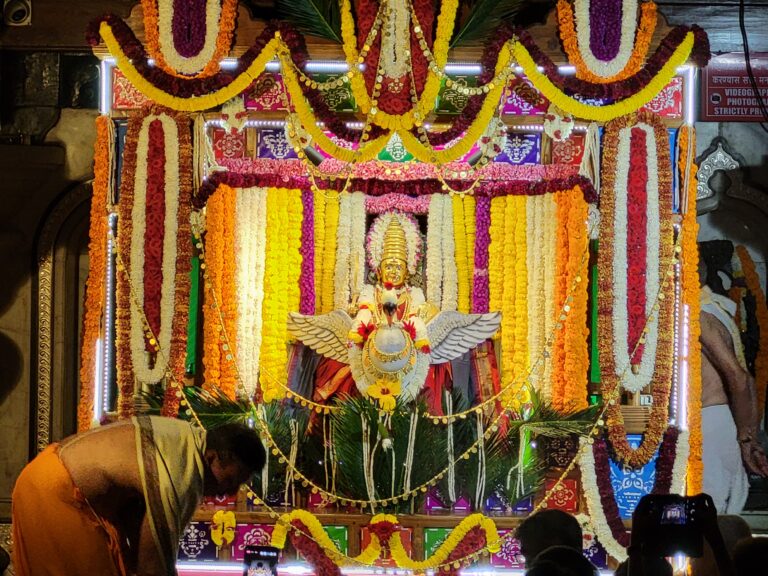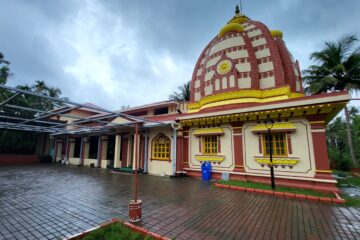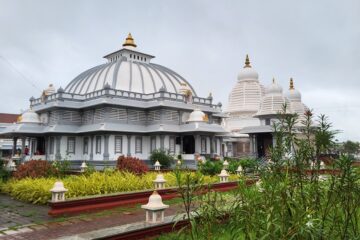A Brief Visit Years Ago
A few years ago, I had the opportunity to visit Keri for a day to attend a residential camp organized by Samskrita Bharati Goa. Our camp was held in a building owned by the Vijayadurga temple, located just across the road behind the temple. Since we were occupied with sessions throughout the day, I could only observe the natural surroundings carefully when we stepped out for lunch.
First Experience of the Temple’s Beauty
We went to the temple to partake in the afternoon Mahaprasad . At the center of a beautifully maintained courtyard, adorned with flowering plants, stood the magnificent temple. Inside the temple, we had a brief but powerful darshan of the radiant idol of Vijayadurga Devi. As time was short, we quickly returned to our camp after the visit. While leaving, the surrounding nature seemed to be inviting us to return. Despite several attempts, a return visit didn’t materialize for a long time.
An Unexpected Return
Finally, this year, quite unexpectedly and without any prior planning, I found myself back at the temple, answering the call that nature had extended years ago.
A Unique Temple Amidst Stunning Nature
This time, I took my time to observe the entire temple, its surroundings, and the idol of the Goddess, taking it all in with full attention. Evening was approaching, and since it was December, the days were shorter.
The Vijayadurga temple at Keri is nestled in the lap of nature — bordered by the village on one side and dense greenery on the other. Apart from festivals and fairs, the temple usually remains calm and less crowded compared to other temples. As a result, there’s a peaceful serene environment without unnecessary hustle and bustle.
The temple is constructed in the traditional Goan style with a tiled roof. As the idol was adorned with festive decorations, I couldn’t see the original form clearly, but she seemed to be Ashtabhuja (eight-armed).
A Temple Amidst Serenity and Purity
The temple structure is extremely neat, and the surrounding area is exceptionally clean. The natural beauty around it is mesmerizing. With no disturbance from traffic, crowds, or nearby settlements, the temple and its surroundings radiate a strong spiritual energy. Not only those with a religious or spiritual inclination, but even individuals otherwise disconnected from such pursuits, are bound to fall in love with this place.
Traditional Goan Temple Architecture
The temple follows the typical layout of Goan temples — a Nagarkhana (drum house), a spacious Sabhamandap (assembly hall), an Antaral (anteroom or vestibule), a central courtyard (Madhyamandap or Chowk), and finally the Garbha Griha (sanctum sanctorum).
The Spacious Sabhamandap and The Airy Antaral
The Sabhamandap is broad and airy, designed primarily for hosting social and religious gatherings. A few steps inside lead to a platform, which has a staircase giving access to the upper gallery. The atmosphere within is calm and welcoming.
Beyond the assembly hall lies the Antaral, a well-ventilated and neat space. Windows on both sides, with built-in stone benches, provide a peaceful spot to sit and admire the beautiful surroundings after offering prayers.
Serene Madhyamandap
The Madhyamandap or Chowk, located ahead of the Antaral, is meant for meditative seating post-darshan. The architectural design ensures it remains cooler than the outer sections. Wide arched windows and large circular pillars enhance its beauty. Such spacious windows are not only on both sides of the central hall (Madhyamandap), but also along the circumambulatory path and beside the doors on either side of the hall. The wide elevated platform above the entrance of this hall, adorned with the Goddess’s makhar, lends the mandap a unique and distinguished beauty
The Distinctive Nagarkhana
The Nagarkhana, a hallmark of traditional Goan temples, is found in only a few temples. It is where instruments like the shehnai, chowghada, and nagada are played during morning rituals. As you enter the Vijayadurga temple through the Sabhamandap, the Nagarkhana is the first structure you encounter. A similar feature is seen at the Mahalsa Narayani temple in Mardol, although positioned above the main entrance. This structure adds a unique charm to the temple’s architectural splendor.
The Majestic Spire and Golden Kalasha
The temple’s spire, crafted with copper elements, crowned by a magnificent golden Kalasha (pinnacle), bestows the temple with a divine and majestic appearance, enhancing its sacred aura even further.
An Attractive and Well-Maintained Temple Complex
After completing the darshan of the Goddess, we took a pradakshina (circumambulatory walk) around the temple. The tiled-roof houses, halls, and other structures surrounding the temple beautifully complemented its serene charm.
Nature’s Grace and Architectural Beauty
Neatly arranged flowering plants on all sides, the sacred Tulsi Vrindavan (basil shrine) at the front, and the Deepastambha (lamp pillar) enhanced the temple’s natural and spiritual beauty. As evening was setting in and darkness was about to descend, we were about to leave.
We entered from the back of the temple and planned to leave before it got dark. As we were about to turn back, we noticed something from the front entrance that left us awestruck.
An Unexpected Moment of Awe
The inherent calmness of the temple deepened as the day faded into twilight. We had originally entered through the pathway at the rear of the temple. Just as we were about to turn back, a sudden impulse made us head toward the main entrance. There, glancing to the right, we were left stunned by the breathtaking sight that awaited us.
The Unique Temple Tanks of Goa
Temple ponds or tanks, either in front of or behind the temple, are a hallmark of Goa’s ancient temples. Following this tradition, there was a tank here as well — but it was unlike any other we had seen.
A Serene River-like Pond and Verdant Groves
This wasn’t just a typical temple pond; it resembled a small, gentle river flowing quietly. Beyond the pond stretched a lush kulagar — a dense grove of coconut and areca nut trees, along with a variety of other plants, creating a breathtakingly green landscape.
Drawn by Nature, Lost in the Moment
Steps led us down to the water tank, flanked on both sides by tall trees where monkeys leapt and played wildly. Forgetting all thoughts of turning back, we were pulled by nature’s charm and descended the steps, reaching the edge of the tank almost without realizing it.
The tank was slightly lower than the last step, and a stone railing with a built-in bench allowed visitors to sit and take in the beauty. From there, we sat and watched a flock of ducks splashing noisily in the water, strings of white egrets flying across the sky, a solitary heron meditating on a nearby rock, and birds chirping excitedly as they hurried back to their nests. We were completely mesmerized — absorbed in capturing glimpses of this natural beauty on our phones and, for a while, forgetting even ourselves.

A Promise to Return Again
We were so enchanted by the moment that we didn’t realize night had quietly fallen around us. A slight eeriness crept into the air, reminding us to return. With hearts full from the darshan of the Goddess and the embrace of nature, we left with a silent promise: next time, we would stay for at least two days. But even before that plan could be made, destiny brought us back once again — unexpectedly, and all of a sudden.
The Unique Makharotsav of Vijayadurga in Margashirsh Navaratri
In most temples across Goa, decorative altars (makhar) are a special feature during the Ashwin Navratri festival. However, we learned from an acquaintance that at the Vijayadurga Temple, these altars are not displayed during Ashwin Navratri, but rather during the month of Margashirsha. Intrigued by this unique tradition, we made a special trip one night to Keri just to witness the makhar ourselves.

An Immersive Experience of Devotion – The Makhar Festival in Goa
Witnessing the Makharotsav in Goa is truly a divine and joyous experience, steeped in devotion. Each temple has its own unique way of swinging the makhar — the decorated seat of the deity — and even the accompanying instrumental music varies slightly from place to place.
At the Vijayadurga temple in Keri, the makhar isn’t just swung forward and backward as in most temples; it is also moved side to side and even rotated completely in a full circle. In the gentle glow of dim lights, the gracefully swinging altar held the resplendent idol of Goddess Vijayadurga, glowing with divine radiance. Surrounded by soul-stirring music and a deeply spiritual atmosphere, we lost ourselves in devotion for a good 30 to 45 minutes.
Afterward, we received prasad and began our return, hearts full and spirits uplifted.
The Village of Renowned Singer Kesarbai Kerkar
Music lovers will be pleased to know that the village of Keri is the birthplace of the renowned Indian classical vocalist, Kesarbai Kerkar. The village proudly houses the Kesarbai Kerkar School, and nearby stands the very home where she once lived.
How to Reach Keri
Located around 30 kilometers from Panaji, nestled in the lap of nature, Keri lies in the Fonda (Ponda) taluka of Goa. From Panaji, one can reach Keri by taking a right turn at Betki village on the Marcel–Savai Verem road — about 5 kilometers ahead. Alternatively, one can reach Keri via the Mardol highway, turning left at Priol and heading straight. If you’re traveling from Belgaum, the distance from Ponda to Keri is approximately 10–12 kilometers.
A Must-Visit for Nature and Temple Lovers
Dear friends, if you are someone who finds joy in nature and appreciates spiritual heritage, don’t miss the opportunity to visit the beautiful Vijayadurga Temple in Keri, Ponda taluka.


